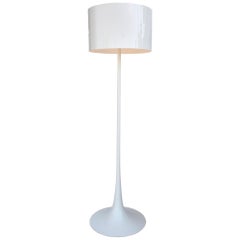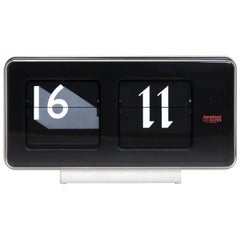Sebastian Wong
Recent Sales
Early 2000s Italian Mid-Century Modern Floor Lamps
Steel
Early 2000s British Modern Table Clocks and Desk Clocks
Plexiglass
Early 2000s British Modern Table Clocks and Desk Clocks
Plexiglass
Early 2000s British Modern Table Clocks and Desk Clocks
Plexiglass
Early 2000s British Modern Table Clocks and Desk Clocks
Plexiglass
A Close Look at Modern Furniture
The late 19th and early 20th centuries saw sweeping social change and major scientific advances — both of which contributed to a new aesthetic: modernism. Rejecting the rigidity of Victorian artistic conventions, modernists sought a new means of expression. References to the natural world and ornate classical embellishments gave way to the sleek simplicity of the Machine Age. Architect Philip Johnson characterized the hallmarks of modernism as “machine-like simplicity, smoothness or surface [and] avoidance of ornament.”
Early practitioners of modernist design include the De Stijl (“The Style”) group, founded in the Netherlands in 1917, and the Bauhaus School, founded two years later in Germany.
Followers of both groups produced sleek, spare designs — many of which became icons of daily life in the 20th century. The modernists rejected both natural and historical references and relied primarily on industrial materials such as metal, glass, plywood, and, later, plastics. While Bauhaus principals Marcel Breuer and Ludwig Mies van der Rohe created furniture from mass-produced, chrome-plated steel, American visionaries like Charles and Ray Eames worked in materials as novel as molded plywood and fiberglass. Today, Breuer’s Wassily chair, Mies van der Rohe’s Barcelona chair — crafted with his romantic partner, designer Lilly Reich — and the Eames lounge chair are emblems of progressive design and vintage originals are prized cornerstones of collections.
It’s difficult to overstate the influence that modernism continues to wield over designers and architects — and equally difficult to overstate how revolutionary it was when it first appeared a century ago. But because modernist furniture designs are so simple, they can blend in seamlessly with just about any type of décor. Don’t overlook them.
Materials: Plastic Furniture
Arguably the world’s most ubiquitous man-made material, plastic has impacted nearly every industry. In contemporary spaces, new and vintage plastic furniture is quite popular and its use pairs well with a range of design styles.
From the Italian lighting artisans at Fontana Arte to venturesome Scandinavian modernists such as Verner Panton, who created groundbreaking interiors as much as he did seating — see his revolutionary Panton chair — to contemporary multidisciplinary artists like Faye Toogood, furniture designers have been pushing the boundaries of plastic forever.
When The Graduate's Mr. McGuire proclaimed, “There’s a great future in plastics,” it was more than a laugh line. The iconic quote is an allusion both to society’s reliance on and its love affair with plastic. Before the material became an integral part of our lives — used in everything from clothing to storage to beauty and beyond — people relied on earthly elements for manufacturing, a process as time-consuming as it was costly.
Soon after American inventor John Wesley Hyatt created celluloid, which could mimic luxury products like tortoiseshell and ivory, production hit fever pitch, and the floodgates opened for others to explore plastic’s full potential. The material altered the history of design — mid-century modern legends Charles and Ray Eames, Joe Colombo and Eero Saarinen regularly experimented with plastics in the development of tables and chairs, and today plastic furnishings and decorative objects are seen as often indoors as they are outside.
Find vintage plastic lounge chairs, outdoor furniture, lighting and more on 1stDibs.
Finding the Right Table-clocks-desk-clocks for You
Whether you’re working on-site or giving your home office the makeover it deserves, a new, vintage or antique table clock or desk clock is a decorative touch that blends ornament and functionality. Who says that a unique desk clock isn’t a meaningful addition to your home office or library? And who says you don’t need a cool clock anymore?
While our means for telling time have evolved from pocket watches to wristwatches and finally to our digital phones, there is likely still a place for a table clock or desk clock in your life, even if it isn’t a modern desk clock.
Antique and vintage clocks appeal to our penchant for nostalgia, whisking us back in time to the 18th and 19th centuries, when clockmakers were busying themselves with designs for objects such as mantel clocks, then ornate pieces that were typically displayed on top of a fireplace. Tabletop clocks and desk clocks are variations on the carriage clock, a small, portable timepiece outfitted with a hinged carrying handle that garnered popularity as the growth of rail travel took shape.
Clocks make great collectibles. More than one mantel clock in your home library is going to elevate the space where your carefully curated stacks of books live, while a well-designed small decorative desk clock can be a fun way to express your personal style. Amid your inkwell, porcelain paperweights and other desk accessories, a desk or table clock designed during the Art Deco or Louis XVI eras, for example, is going to stand out in your workspace as a striking accent.
Since new, vintage and antique tabletop and desk clocks are not as common in today’s interiors, these objects will make a statement in yours. Find a spectacular clock on 1stDibs now.

